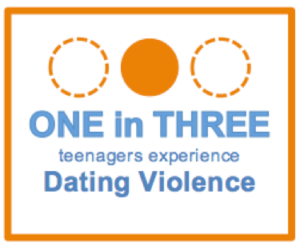
Dating and relationships are an important part of growing up. All relationships have qualities that can make them healthy, abusive, or somewhere in between. Being in a dating relationship can mean different things to different people. Whether you’re official, dating, talking, or hooking up, you and your partner deserve to be treated with respect.
What is Dating Violence?
“Dating violence” refers to dating relationships with any type of abuse (physical, emotional, sexual, and digital).
Anyone can be a victim of abuse or behave in an abusive way regardless of their gender identity, sexual orientation, or sexual practices. Someone can also experience abuse and behave abusively in their relationship at the same time.
You may have an idea about what dating violence or abusive relationships look like from your own experiences or what you have seen in other people’s relationships, your culture, TV, movies, or online. While many people know something about dating violence, there is still a lot to learn– around half of college students say it’s hard to identify dating violence. This guide will give you more information about dating violence and how to get help.
How common is Dating Violence?
 Dating violence is common among teenagers and young adults. It is hard to know exactly how many people experience dating violence because many victims never tell anyone about the abuse.
Dating violence is common among teenagers and young adults. It is hard to know exactly how many people experience dating violence because many victims never tell anyone about the abuse.
- About 1.5 million high school students report physical abuse from a partner in the US every year.
- Around 10% of high school students have experienced sexual abuse.
- People between 18 and 24 years old have the highest rates of stalking in the US.
- More than half of people who experience abuse in adult relationships report their first experience with dating violence occurred between the ages of 11 and 24.
Because this is such a common issue, it is likely that you or someone you know is affected by dating violence. It is important for you to be able to recognize the signs and know how to get help.
What makes a relationship healthy, unhealthy, or abusive?
Healthy relationships are based on mutual respect, good communication, and equality. Each partner is appreciated and valued in a healthy relationship. However, this doesn’t mean the relationship or partners are perfect. Even in healthy relationships, a partner can make a mistake. What makes the relationship healthy is that even in conflicts or disagreements, you should be able to tell your partner how you feel, and they should respond in a way that makes you feel safe and supported.
Unhealthy relationships are somewhere in between healthy and abusive. One person may try to make most of the decisions or control how the other person acts. Some examples of unhealthy behaviors are:
- Imbalance: Your partner always decides what restaurant you eat at or where you go on a date.
- Inconsiderate behavior: You ask your partner not to call you when you are visiting your grandmother, but they call you multiple times anyways.
- Holding grudges: Your partner gives you the silent treatment after you decide to go to the movies with a friend instead of hanging out with them.
- Poor communication: After a disagreement, your partner avoids you instead of telling you what is bothering them.
Abusive relationships can include physical violence, but that is not the only kind. There are many types of violence that can take place in a relationship, including physical, emotional, sexual, and digital abuse. Some of these might be harder to recognize than others, and they can all be serious. In general, abusive relationships are based on unequal power and control. Some examples of abusive behaviors are:
- Anger
- Blame
- Manipulation
- Stalking
- Isolation
- Pressure
- Lies
- Threats
What is physical abuse?
Physical abuse is when another person intentionally touches you in an unwanted way or comes in close contact to your body. Physical abuse can be painful, leave a bruise, or cause an injury- but it doesn’t always. All types of physical abuse are serious.
A few examples of physical abuse are:
- Hitting, slapping, grabbing, or kicking
- Choking or strangling
- Throwing objects at you, even if it doesn’t hit you
- Using a weapon (such as a gun, knife, bat, or other object)
What is emotional abuse?
Emotional (or verbal) abuse is when a person says or does something that makes you feel afraid or bad about yourself. It can also include constant monitoring or stalking. Some people believe that emotional abuse isn’t as serious as physical abuse, but we know that isn’t true. Experiencing emotional abuse can affect your self-esteem and confidence. All types of abuse are wrong, and you never deserve to feel controlled or afraid in your relationship.
A few examples of emotional abuse are:
- Threatening to harm you or themselves if you break up with them
- Yelling at you or blaming you for their actions
- Embarrassing you on purpose or calling you names
- Controlling what you wear or who you spend time with
- Saying they will reveal your secrets if you don’t do what they say
What is sexual abuse?
Sexual abuse refers to any unwanted sexual contact or any sexual contact when someone doesn’t have the ability to control their sexual activity (they are passed out or intoxicated). All sexual contact requires enthusiastic consent. If someone doesn’t resist sexual contact, that doesn’t mean they consent. A person may not resist an unwanted sexual act for many reasons. For example, they are afraid of getting hurt if they fight back or cannot say “no” because they are intoxicated or passed out. Just because a person has consented to a sexual act, this doesn’t mean they can’t change their mind in that moment or in the future. Sexual abuse doesn’t have to be violent or leave a mark. People can experience sexual abuse from anyone, including a stranger, friend, dating partner, or a spouse.
Some types of sexual abuse are harder to recognize, like refusing to use condoms when asked or saying, “if you loved me, you would have sex with me.”
A few examples of sexual abuse are:
- Any unwanted sexual contact (kissing, touching, penetration)
- Sexual contact with someone who can’t consent (they are passed out or intoxicated)
- Using threats or bribes to get someone to do sexual acts
- Using a weapon or physical force to make someone perform sexual acts
- Name calling or unwanted violent behavior during sex
- Pressuring or forcing a partner to have sex with or perform sexual acts to someone else
What is digital abuse?
Digital abuse is when a partner uses technology to bully, harass, control, stalk, or intimidate a partner. Technology is a great way to stay in touch and connected with the people you care about, especially your partner. Your partner should not try to control how you use technology or social media and shouldn’t use technology to try to control you. Remember, all healthy relationships have boundaries – and this includes technology. Try having a conversation with your partner at the beginning of your relationship to help establish these boundaries (for example: Will you use each other’s phone? Will you check-in to share location? Will you post about your relationship on social media?).
Some examples of digital abuse are:
- Demanding to have access to your passwords or messages
- Texts you excessively and gets mad if you don’t respond
- Tells you who you can be friends with or follow on social media
- Keeps tabs on who you are texting, calling, or messaging
- Pressures you to send explicit videos, pictures, or texts
- Uses GPS or social media to know your location
How can I get help?
Whether you want to get help for yourself or a friend, want to learn more about dating violence, or think you may be acting abusively in your relationship, there are many resources available to you. Here are a few of our favorite resources, and if you want to learn more about resources, visit our “How to get help” guide.
Call
- National Teen Dating Abuse Helpline
- 1-866-331-9474 or 1-866-331-8453 for TTY
- National Domestic Violence Hotline
- 1-800-799-7233 or 1-800-787-3224 for TTY
- LGBTQ-Friendly Resources
- The GLBT Talkline: 1-888-843-4564
- GLBT Youth Talkline: 1-800-246-7743
- The Trans Lifeline: 1-877-565-8860
Text/Chat
- Go to Loveisrespect.org for the most updated information on texting/chatting with a peer advocate.
Websites
 Young Men's Health
Young Men's Health
